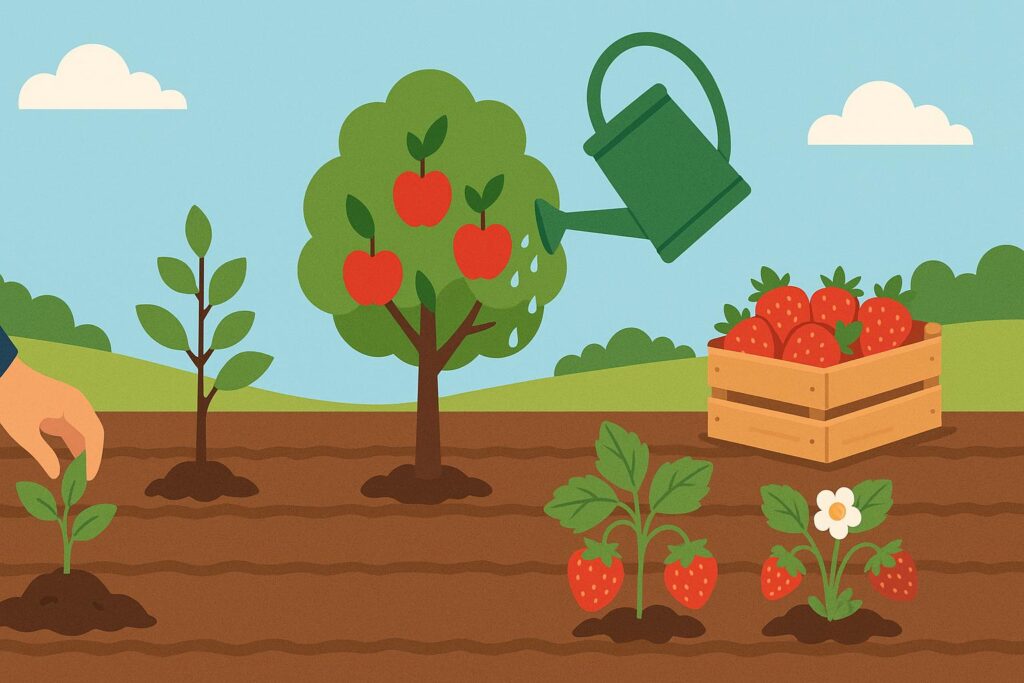Growing fruits can be both a fulfilling passion and a smart income stream. But the idea of profitability within just 90 days may sound ambitious, even improbable. However, with the right strategy, fast-growing fruit varieties, and smart market planning, it’s entirely possible. Across India and other subtropical regions, many small-scale and commercial farmers are turning to rapid-cycle fruit cultivation to generate income in a short span of time.
This 90-day plan isn’t just about planting and waiting. It’s a calculated timeline designed to take advantage of short-duration crops, effective planting schedules, and efficient post-harvest strategies. Whether you own land or plan to grow in containers, the goal is clear: quick harvest, quick turnover, and consistent profit.
Let’s explore how you can make this happen with practical steps, crop choices, and actionable methods tailored to different climates.
the 90-Day Window: Why It Matters
The need for fresh, locally farmed produce, volatile markets, and unpredictable weather have all contributed to an increase in time-sensitive farming. A 90-day cycle provides flexibility, quickness, and lower risk. Farmers can benefit from rapid yielders and specialty markets rather than waiting for seasonal long-haul crops.
The primary goal of this strategy is to select fruit varieties that mature or begin to produce within three months. However, it doesn’t stop there. Important factors also include local demand, market accessibility, input costs, and soil health. Nowadays, a lot of growers are switching from conventional methods to fast-cycle models since they provide:
- Shorter investment-to-revenue cycle
- Ability to test and adapt based on demand
When beginning this journey, you must also factor in seed quality and germination reliability. Many growers opt to purchase fruit crop seeds from trusted online sources, which offer climate-specific options and higher germination rates. Investing in reliable seeds sets the foundation for the rest of the plan.
Choosing Fruits That Grow Fast and Sell Well
Not all fruits are created equal—especially when you’re racing against the clock. Some fruits naturally bear fruit or reach harvestable stages faster than others. In this plan, we focus on short-cycle fruits like strawberries, papayas (from tissue culture), bananas (G9 variety), and even lesser-known options like muskmelon and watermelon in specific regions.
Strawberries, for instance, can start yielding in about 60–75 days with proper care. Similarly, dwarf papaya hybrids start giving returns within 80–90 days of planting, especially when grown from advanced saplings.
Watermelons and muskmelons grow well in dry or semi-arid climates and are ready for harvest in as little as 65 days. They are ideal for seasonal bursts of income.
Example from Tamil Nadu’s Melon Belt
In Erode district, farmers who switched to 75-day muskmelon varieties reported over 25% better income than their traditional paddy yields. The short cycle allowed them to plant twice within the same season.
Setting Up the Land for Fast Results
It is imperative that the soil and layout be done correctly. These fruits require consistent hydration from day one, well-prepared beds, and excellent nutrient availability because of their short turnaround time.
Start by determining the pH and drainage capacity of your soil. The majority of fruits that develop quickly prefer slightly acidic soil (pH 6.0–7.0) to neutral soil. Bananas and papayas like well-drained pits with organic compost, while melons and strawberries thrive in raised beds.
For a controlled water supply that not only saves water but also lowers the risk of fungal disease, use drip irrigation. For crops like muskmelons and strawberries, mulching with dried leaves or biodegradable film helps preserve moisture and inhibit weed growth.
Don’t Skip These Basics
- Use farmyard manure or vermicompost as a base before planting.
- Install shade nets in high-temperature areas for tender crops like strawberries.
Maintenance and Fertilization: The Mid-Phase Push
Your fruit plants are in their vital growth stage between days 30 and 60. Careful timing of fertilization is necessary during this time to avoid illness or stunting. Fermented compost teas, fish amino acids, and neem cake are examples of organic solutions that offer nutrients without compromising the soil microbiology.
Plants like papayas and bananas may need to be pruned and de-suckered in order to redirect energy to the main stem. Cutting out runners early on in strawberries will direct the plant’s energy towards fruiting.
“Your farm doesn’t need to be big. It just needs to be smart.”
Using biostimulants can improve root development and flowering, especially during temperature stress. This phase also includes regular pest scouting to catch infestations early without heavy chemical use.
Harvesting, Packaging, and Selling: Where Profit Begins
Your fruits will be ready to harvest or close to their initial yield by days 70 to 90. Your early choices about crop timing, seed choice, and local demand begin to pay off at this stage. Strawberries and muskmelons require careful harvesting and prompt packaging to prevent spoiling.
Purchasing basic grading and packing equipment can have a significant impact on both sale price and shelf life. Particularly for perishable fruits, local markets, online delivery, and even direct-to-consumer sales are now feasible.
In order to reach wholesale clients and get greater margins and a quicker turnaround, many farmers also post their produce on websites such as AgriMarket.
Diversify and Stack for Maximum Return
When combined with other crops or incorporated into a polyhouse or greenhouse system, a 90-day cycle might yield even greater profits. For instance, Punjabi farmers use marigold borders around strawberries to boost pollination and discourage pests.
Techniques like trellising and vertical farming enable even greater space optimisation. A farmer can use a multi-cropping technique to produce melons on the ground and climb beans or gourds using vertical nets.
This approach decreases pest accumulation, increases soil diversity, and maximises available area.
Applying the 90-Day Model Across Seasons
The 90-day approach is applicable throughout the year, even if the crops may change. Strawberries and melons do well in the spring; papayas and bananas do well in the monsoon; in the cooler months, consider fast-maturing grapes or young pineapples in polyhouse arrangements.
To optimise your planting schedules, consult local meteorological data and crop calendars. Actually, the Indian Meteorological Department provides farmers with current information to help them more precisely modify irrigation schedules and planting windows.
Remember to switch up your crops each season to keep the soil fertile. In order to fix nitrogen in the soil, plant legumes like cowpea in between fruiting cycles.
Frequently Asked Questions
- What fruits grow the fastest for commercial sale?
Strawberries, muskmelons, and dwarf papayas are among the fastest to grow and fetch good market value within 90 days. - Can I grow fruits in containers under this plan?
Yes. Many growers use grow bags or containers for strawberries and dwarf varieties of papaya and banana, especially in controlled environments. - How much profit can I expect from a 90-day fruit cycle?
Profit depends on fruit type, market access, and growing conditions. For example, one acre of strawberries can generate ₹3–4 lakhs in a single cycle under optimal conditions. - Do I need a greenhouse to follow this plan?
Not necessarily. However, greenhouses or shade nets can significantly improve yield and reduce pest pressure, especially in extreme climates. - How do I manage pest control without heavy chemicals?
Use neem oil sprays, yellow sticky traps, and regular crop inspection. Companion planting and crop rotation are also effective organic strategies.
The Takeaway: Grow Fast, Grow Smart
The 90-day strategy emphasizes making wise decisions in addition to speed. A tiny plot of land can become a reliable source of income if you choose the proper fruit, prepare your soil intentionally, and keep up with market trends. Every cycle offers a chance to grow, adapt, and learn.
This style provides versatility without sacrificing yield or quality, whether you’re growing in an open field or on a rooftop. Harvest after harvest, let the next ninety days serve as your springboard to successful farming.








Leave a Reply